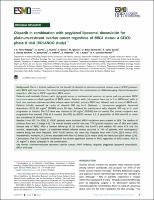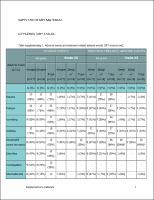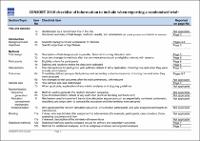| dc.contributor | Vall d'Hebron Barcelona Hospital Campus |
| dc.contributor.author | Perez-Fidalgo, J. A. |
| dc.contributor.author | Cortés, A. |
| dc.contributor.author | Guerra, Eva |
| dc.contributor.author | García, Y. |
| dc.contributor.author | Iglesias, M. |
| dc.contributor.author | Bohn Sarmiento, U. |
| dc.contributor.author | Oaknin Benzaquen, Ana Mazaltob |
| dc.date.accessioned | 2022-03-23T12:18:26Z |
| dc.date.available | 2022-03-23T12:18:26Z |
| dc.date.issued | 2021-08 |
| dc.identifier.citation | Perez-Fidalgo JA, Cortés A, Guerra E, García Y, Iglesias M, Bohn Sarmiento U, et al. Olaparib in combination with pegylated liposomal doxorubicin for platinum-resistant ovarian cancer regardless of BRCA status: a GEICO phase II trial (ROLANDO study). ESMO open. 2021 Aug;6(4):100212. |
| dc.identifier.issn | 2059-7029 |
| dc.identifier.uri | https://hdl.handle.net/11351/7255 |
| dc.description | PARP inhibitor; Olaparib; Platinum-resistant recurrent ovarian cancer |
| dc.description.abstract | Background
There is limited evidence for the benefit of olaparib in platinum-resistant ovarian cancer (PROC) patients with BRCA wild-type tumors. This study investigated whether this combination of a DNA-damaging chemotherapy plus olaparib is effective in PROC regardless BRCA status.
Patients and methods
Patients with high-grade serous or endometrioid ovarian carcinoma and one previous PROC recurrence were enrolled regardless of BRCA status. Patients with ≤4 previous lines (up to 5 in BRCA-mut) with at least one previous platinum-sensitive relapse were included; primary PROC was allowed only in case of BRCA-mut. Patients initially received six cycles of olaparib 300 mg b.i.d. (biduum) + intravenous pegylated liposomal doxorubicin (PLD) 40 mg/m2 (PLD40) every 28 days, followed by maintenance with olaparib 300 mg b.i.d. until progression or toxicity. The PLD dose was reduced to 30 mg/m2 (PLD30) due to toxicity. The primary endpoint was progression-free survival (PFS) at 6 months (6m-PFS) by RECIST version 1.1. A proportion of 40% 6m-PFS or more was considered of clinical interest.
Results
From 2017 to 2020, 31 PROC patients were included. BRCA mutations were present in 16%. The median of previous lines was 2 (range 1-5). The overall disease control rate was 77% (partial response rate of 29% and stable disease rate of 48%). After a median follow-up of 10 months, the 6m-PFS and median PFS were 47% and 5.8 months, respectively. Grade ≥3 treatment-related adverse events occurred in 74% of patients, with neutropenia/anemia being the most frequent. With PLD30 serious AEs were less frequent than with PLD40 (21% versus 47%, respectively); moreover, PLD30 was associated with less PLD delays (32% versus 38%) and reductions (16% versus 22%).
Conclusions
The PLD–olaparib combination has shown significant activity in PROC regardless of BRCA status. PLD at 30 mg/m2 is better tolerated in the combination. |
| dc.language.iso | eng |
| dc.publisher | Elsevier |
| dc.relation.ispartofseries | ESMO Open;6(4) |
| dc.rights | Attribution-NonCommercial-NoDerivatives 4.0 International |
| dc.rights.uri | http://creativecommons.org/licenses/by-nc-nd/4.0/ |
| dc.source | Scientia |
| dc.subject | Quimioteràpia combinada |
| dc.subject | Avaluació de resultats (Assistència sanitària) |
| dc.subject | Ovaris - Càncer - Tractament |
| dc.subject.mesh | Ovarian Neoplasms |
| dc.subject.mesh | /drug therapy |
| dc.subject.mesh | Antineoplastic Combined Chemotherapy Protocols |
| dc.subject.mesh | /therapeutic use |
| dc.title | Olaparib in combination with pegylated liposomal doxorubicin for platinum-resistant ovarian cancer regardless of BRCA status: a GEICO phase II trial (ROLANDO study) |
| dc.type | info:eu-repo/semantics/article |
| dc.identifier.doi | 10.1016/j.esmoop.2021.100212 |
| dc.subject.decs | neoplasias ováricas |
| dc.subject.decs | /farmacoterapia |
| dc.subject.decs | protocolos de quimioterapia antineoplásica combinada |
| dc.subject.decs | /uso terapéutico |
| dc.relation.publishversion | https://doi.org/10.1016/j.esmoop.2021.100212 |
| dc.type.version | info:eu-repo/semantics/publishedVersion |
| dc.audience | Professionals |
| dc.contributor.organismes | Institut Català de la Salut |
| dc.contributor.authoraffiliation | [Perez-Fidalgo JA] Department of Medical Oncology, Hospital Clínico Universitario de Valencia, Valencia, Spain. [Cortés A, Guerra E] Department of Medical Oncology, Hospital Universitario Ramón y Cajal, Madrid, Spain. [García Y] Department of Medical Oncology, Parc Taulí Hospital Universitari, Institut d'Investigació i Innovació Parc Taulí (I3PT), Universitat Autònoma de Barcelona, Sabadell, Spain. [Iglesias M] Department of Medical Oncology, Hospital Son Llatzer, Palma De Mallorca, Spain. [Bohn Sarmiento U] Department of Medical Oncology, Hospital Universitario de Gran Canaria Doctor Negrín, Las Palmas De Gran Canaria, Spain. [Oaknin A] Servei d’Oncologia Mèdica, Vall d'Hebron Hospital Universitari, Barcelona, Spain |
| dc.identifier.pmid | 34329939 |
| dc.identifier.wos | 000703610200048 |
| dc.rights.accessrights | info:eu-repo/semantics/openAccess |



